As I mentioned, it is very humid here. As I also may have mentioned, my hair isn't a huge fan of the weather.
Breakfast in Airlie Beach followed by the drive to Townsville via Cape Gloucester and Bowen.
Him Outdoors stopped off for a run in the midday sun (we've discussed this before, I'm sure...) while my knee ached so I fossicked among the coral on the beach and read my book in the shade.
 |
| Gloucester Iced Tea at Cape Gloucester |
I heard that there was a lighthouse nearby, so of course we had to take a trip to see it. The North Head Lighthouse is on North Head Island, and was in use until 1985. Originally known as Port Dennison, this was the first port established in North Queensland, and the settlement of Bowen, located on its shore, was officially proclaimed in 1861,named after Queensland's first governor, Sir George Ferguson Bowen. Apparently, since restoration in 2017, the community have an annual Walk to the Lighthouse Day. It takes place sometime in July-August, but sadly, it was not advertised for when we passed through.
 |
| How's that for a bar with a view? |

Between Bowen and Townsville there are a lot of fields of sugar cane. There's not much else, actually, and I was getting strong Summer of the Seventeenth Doll vibes.
We rolled into Townsville as it got dark. It's still warm though.



In the morning we went for a walk along the beach and parade. There were several artworks to engage me, so I appreciated them, while Him Outdoors gauged the course ahead.
 |
| Coconuts (1999) by Thierry Auriac |
'Five oversized coconuts scattered near a group of palms suggest the spontaneity of nature. As if they have just fallen and casually rolled into place, these sculptures are playful icons or emblems of the tripics. Thierry Auriac was born in Paris where he trained as a graphic designer. He arrived in Australia in 1976 and consolidated his installation art practice during the 1990s.'
 |
| Not a sculpture; but a warning |
 |
| Wars (2013) by Stephen Newton |
These granite pillars reflect the rugged headland of Kissing Point, and represent the strength and endurance of a people and a country during wartime. The images, dates and fragments of text refer to the role of Townsville and Kissing Point, the Kennedy Regiment and 31st battalions in theatres of war around the world.
The sculpture trail heads up to the fort at Kissing Point, which is 'a fine example of the fixed coastal defences constructed in Queensland in the nineteenth century, Through its continuous military use from 1865 to 2006 Kissing Point has been associated with many major phases in Australia's defence.
The fort was completed in 1891 as part of colonial Queensland's defence plan after most British troops were withdrawn from the colonies in 1870.'
 |
| View of Magnetic Island from Kissing Point |
'The defence of Townsville was seen as vital to the protection of the nearby goldfields and rich pastoral lands. These concerns and the fear of invasion by other colonising powers active in the Pacific led to the construction of forts in Brisbane, Townsville and on Thursday Island off the tip of Cape York.
In 1881 Queensland commissioned Lt Col Peter Scratchley, a British military expert, to give detailed defence advice. He recommended a small battery and magazine with at least two 64-pound rifled guns for Townsville.
The fort was intended to protect shipping in the port and to defend the north-western approaches to the harbour. A fort on Magazine Island, now demolished, was built to defend the eastern and north-eastern approaches. Forts like these were a standard means of protecting harbours, cities and strategic coastal sites throughout the British Empire.
The original battery consisted of two gun emplacements with an underground storage magazine in between. Casemate storage and communication rooms were built into the parapet to the west of the guns, near the entrance gate. An iron palisade three metres high protected the fort on the landward side.'
'Elements constructed later include machine-gun locations, a small parade ground, and two Second World War searchlight positions.
Guns were first installed at Kissing Point in 1885, and in May that year the first annual training encampment for north Queensland's volunteer forces took place in Townsville.
In 1886 the 3rd Queensland Regiment (the Kennedy Regiment) was officially proclaimed. In 1889 the annual encampments moved to Kissing Point and construction of the fort began.
Since Federation, Kissing Point and the Kennedy Regiment and 31st battalions have had a role in mobilisations and training for the (second) Boer War, the First World War, the Second World War and subsequent conflicts, including East Timor.'
 |
| Coming Together (2013) by Stephen Newton |
This sentinel celebrates the handover of this site to the people of Townsville in 2009. It acknowledges the Aboriginal people, settlers, and military who have used this land for many years.
'By the time the First World War broke out in 1914, Kissing Point Fort had been a part of Queensland's northern defences for over 25 years, serving as a focal point for the land forces of the north.
Although the military had long been wrangling over the best way to defend the coastline of such a large continent, the people of Townsville and north Queensland were reassured by the fort's presence.
After Federation in 1901, the volunteer defence forces of the colonies were incorporated into the Commonwealth Military Forces as the Citizen Forces. The Kennedy Regiment, renamed several times during this period, continued to train and hold annual camps at Kissing Point until Australia went to war in 1914. Australia fielded the largest entirely volunteer citizen army of any country involved in the First World War. Within days of war being declared, the 2nd Infantry (Kennedy Regiment) was mobilised and embarked from Townsville to garrison Thursday Island.'
'In 1915 the 31st Infantry Battalion AIF was raised, comprising two companies of Victorians and two companies from Queensland, including members of the Kennedy Regiment. The men of the 31st fought in many battles including Fromelles, the Somme, Polygon Wood, Bapaume, Bullecourt, Ypres, Ancre, Albert, Amiens, the Hindenburg Line and St Quentin Canal.
Throughout the war the Kennedy Regiment remained an active unit of Australia's Citizen Forces (renamed Citizen Military Forces in 1916). When the war ended, Kissing Point again became the site of annual camps, training and drills for the Kennedy Regiment, which was redesignated the 31st Infantry Battalion after the AIF Battalion with which it was most closely associated.
Although the Kissing Point complex continues to play an important role for the citizen forces of north Queensland, the fort itself had been declared obsolete by Lord Kitchener in 1911. Cleveland Bay was considered too shallow to allow modern warships to approach, effectively removing the very threat the fort was intended to repel.'
 |
| Fish Trap (2013)by Carly Kotynski |
This artwork is a celebration of the Aboriginal stonewall fish trap off Kissing Point, which locals believe was destroyed by a cyclone in the 1970s. Fish would be caught in the trap at low tide. The sculpture also alludes to the cocky apple and the barramundi. For local Aboriginal people when the cocky apple blooms it is barramundi time.
'For three nights in July 1942 the sky above Townsville was lit by searchlights and tracers as Allied forces battled Japanese aircraft on long-distance bombing raids.
At this point in the Second World War, the Japanese perimeter extended from Burma in the west to the Solomon and Marshall islands in the Pacific. In New Guinea, just north of Australia, Allied forces were battling the Japanese advance south on the Kokoda Track.
By this time Townsville had become an important strategic base in the Pacific. The Japanese were determined to stop the Allies from using bases in northern Australia, and in February and March had attacked Darwin and Broome to deadly effect.
Since then Townsville's population had exploded [unfortunate use of word] as US and Australian forces gathered and the city became a major resupply and troop transit port.'
 |
| Big Wind Coming (2013) by Stephen Newton. Shirley Collins & Susan Peter |
This sentinel alludes to the importance of the stars and the moon in Aboriginal life and how these are read in relation to the weather. The central and tallest stone - the Listening Looking Stone - is a place of refuge, observation and contemplation surrounded by the Southern Cross Boulders, which hold water and reflect the stars at night.
'On 25 July 1942 two Japanese Kawanishi H8K ('Emily') flying boats loaded with bombs took off from Rabaul in New Guinea and headed south. Shortly before midnight the planes slipped over Townsville from the north-east.
As the flying boats circled above their target, searchlights around the city pierced the sky, including the two located here at Kissing Point Fort. Caught in the lights, the planes headed out to sea. An hour later they were back, only to drop their bombs in the harbour, missing the wharves where three vessels were berthed.
The second raid, early on the 28th of July, also missed its mark, the bombs landing on bushland beyond the town.
On the night of the third raid, early in the morning of the 29th, two American fighter planes duelled with a lone Japanese flying boat caught in the searchlights.
In a live report of the bombing, ABC radio journalists described the spectacle as tracers and searchlights find the attacking aircraft with the muffled thump of bombs and bursts of anti-aircraft fire interrupting the commentary [this recording can be played at the fort].
All but one of the bombs landed harmlessly in the sea. The last bomb hit the racecourse, breaking a few windows in nearby houses.'
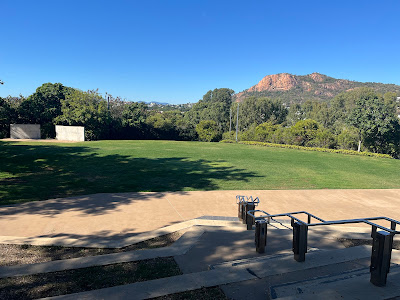 |
| The Crossed Boomerang Amphitheatre |
'The Traditional Owners of this land are the Wulugurukaba people and the Bindal people, who retain an enduring 'connection to country' despite the impact of non-Indigenous settlement in the area.
Garabarra is a significant area for the Traditional Owners because of its cultural importance as the centre of a common food foraging area, as a major route between Aboriginal living and ceremonial places, and as a frontier place in the early post-contact history of Townsville.
Jezzine Barracks (Kissing Point Fort) also has a strong and special association for Aboriginal servicemen and women and their families.'
 |
| Canoe People (2013) by Billy Doolan and Amanda Feher |
The canoe was an important symbol for the local Aboriginal peoples in both trade and harvesting from the rivers and sea. Wulgurukaba translates to 'Canoe People'. Kissing Point and Rowes Bay were traditional meeting places for local peoples.
'The Wulgurukaba people and Bindal people foraged for food over a large area of this coast, including the nearby dunes, flats and shoreline, the wetlands of the Town Common area to the immediate north and west of Kissing Point, the riverine habitats of the Ross, Bohle and Black river corridors, Cape Pallarenda, and the rich resources of Magnetic Island just off the coast across Cleveland Bay.
Current archaeological evidence shows Aboriginal people have occupied the immediate Townsville area for at least 4000 years.
Garabarra continues to be visited today by local Aboriginal people for fishing, collecting shellfish (mainly oysters) and foraging for bush tucker (such as Burdekin Plum) and other natural resources.'
 |
| Belonging (2013) by Carly Kotynski and Gavin Kum Sing |
This sentinel depicts the main creation story of the Townsville region - the story of the travels of Gabul the carpet python. It shows Gabul weaving his way along the coastline from Cape Pallarenda to Cape Cleveland, forming the landscape and bringing the people and the animals to the land.
'For Indigenous Australians the Dreamtime is the time when ancestral beings moved across the land, creating all the animals and plants and forming the landscape that we know today. The main creation story for this area describes the journey of Gabul, the carpet snake, and how he created significant landforms in the region.
Gabul came from the north, beyond Hinchinbrook Island, slithering south to form the channel between Hinchinbrook Island and the coast. He wriggled south again to form the Palm Islands, skirting the east coast of the largest island in the group in a great loop. He rested there for a while and then moved on through Halifax Bay to Magnetic Island. Gabul rested his head at Arcadia and West Point, and then made his way across the water to form the Ross River just south of Garabarra as he headed up into the mountains.'
 |
| Crocodile by Rurik Henry and Jordan Wyles |
Rurik Henry has transformed Jordan Wyles' drawing of a crocodile into this sculpture of marine stainless steel. The crocodile is an important symbol of strength and longevity for some Aboriginal groups.
'The creation stories that describe the travels of ancestral beings place Indigenous Australians in their country. These stories are passed from generation to generation through storytelling, artwork, dancing, song and ceremony.'
 |
| Crow (2013) by Rurik Henry |
For some Aboriginal groups this creation story explains how crows came to be black: A long time ago all crows were white. One day a crow was eating alone with a bag around his neck. A snake and a goanna asked an eagle to see if there was magic in the bag. The eagle grabbed the bag but the bag broke and out spilled fire. Not wanting to share the fire, the selfish crow rolled in it to put it out, blackening himself in the ashes.
'Local Elders tell many other Dreamtime stories. One well-known story concerns the creation of Castle Hill. The waters rose up drowning the riverbeds and the last kangaroo in the rainforest moved back up into the dry hills. A dingo thought the kangaroo looked like a tasty snack and chased it back down to the coast.
The kangaroo jumped off the end of Guliman (Cape Cleveland) and he is sitting in water up to his neck and the dingo comes down and pops right in town, his front paws in Melton Terrace, his head and shoulders are the lookout , his backbone is where you drive up, his back legs are Yarrawonga, his tail runs out to West End... so when we look at him from the north, that is how we see Castle Hill.'
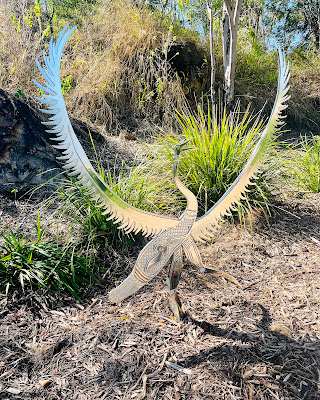 |
| Brolga by Rurik Henry and Jeremy George |
Jermey George's livley painting of a brolga catching a fish has been transformed by Rurik Henry into the stainless steel sculpture. George says he likes to paint things he has seen - brolgas dancing and catching fish, carpet snakes and butterflies, lots of butterflies.
 |
| Seven Sisters (2013) by Karen Doolan and Amanda Feher |
Dance and art are both very important to Karen Doolan and the two come together in this work. The sculpture is based on a drawing by Doolan, and celebrates women and their importance in Aboriginal culture. Her drawing was inspired by the creation story of the seven sisters who came down from the heavens bringing everything that was beautiful in the world. This is women's business.
'The seasons of winter, spring, summer and autumn were unknown in this land before the arrival of Europeans. Indigenous Australians also divide the year into seasons, but the vast expanse of this continent, stretching as it does from near the equator to the Southern Ocean, means these seasons vary greatly from place to place.
Australian landscapes include deserts, rainforests, floodplains, mountains, islands and thousands of kilometres of coast; climates vary from tropical to temperate, from continental to maritime. Indigenous seasons vary greatly in number and duration and are often divided into different stages.
Here in the Townsville area, Aboriginal people talk about two main seasons, the Wet and the Dry, but within these broad seasons the calendar is dictated by what else is happening in the natural world. For example, when the Cocky Apple blooms at the end of the Dry season it sends a message to local Aboriginal people about the barramundi, a delicious and much-prized fish that grows so large one fish can feed many people.'
 |
| Bush Honey (2013) by Amanda Feher and Susan Peters |
The Honey Grevillea Flowers represented here were used as a source of sweet nectar and a cooling drink by Aboriginal people in hot weather. The nectar was known as wild honey, and was used extensively throughout the region.
 |
| Dilly Bag and Fruit (2013) by Bernadette Boscacci and Shirley Collins |
This work represents the seasonal abundance of native fruits, and the knowledge and resourcefulness of the local Aboriginal people who wove vessels for gathering and storing their food.
'The Dry season is also the time for cleaning up country, for a carefully planned tending of the land by fire. The lush growth of the Wet season has shrivelled into impenetrable masses of field grasses and shrubs, difficult to travel through, difficult for hunting. This is the time for the seasonal burn-offs that will regenerate the land.
Fresh green pick then grows through the ashes, tempting wallabies and other animals out into the open for easy hunting. After a burn-off many important bush tucker and other plants regenerate and multiply, ensuring food and resources for the future.'
 |
| Fire Starter (2013) by Virginia Wyles and Antone Bruinsma |
Fire or 'burri' has served many important purposes in daily Aboriginal life. Fire starters were made from soft wood comprising a mother board and drill stick. Fire was made by rapidly twirling the drill stick with both hands into the mother board that had a little fine sand or grit added to create friction.
 |
| Flex (2013) by Amanda Feher |
Amanda Feher's permanent public artwork, Flex, timed to be unveiled on The Strand during the 2013 Strand Ephemera, has been commissioned 'in recognition of the resilience shown by the Townsville community during and after Cyclone Yasi (February 2, 2011).
Feher has lived in the Far Northern Region her whole life, and has completed numerous public art commissions, while also particiapting in a number of Strand Ephemera exhibitions since its inception in 2001.
"I'm pleased to present a work which relates to an important part of life in the North; the Weather. The sculpture is comprised of three main elements which, both together and independently, symbolise the natural regeneration and re-building after a disaster occurs.The Olive Backed Sunbird is native to the north and Townsville area. If the Olive Backed Sunbird's nest is damaged by weather, they will often return to repair and inhabit the same nest again, or rebuild close by. Originally a mangrove dwelling species, the highly adaptable Sunbird has successfully inhabited and bred in cultivated and urban landscapes. The Sunbird, with all its traits, lends itself as the perfect symbol of resilience.The Grass Blade form represents the tumultuous local environment, with its flexibility when long, and its ability to regrow after being cut down. This is also true of many of the people who rebuild after their homes are damaged in Natural Disaster Events, which are typical of the region.Below the sculpture, the landcsaping forms an Isobaric Ring configuration and references Storm Radar Map colour schemes with which we are familiar from weather maps televised during extreme weather events."
 |
| Bazza and Shazza (2004) by Jan Hynes |
Bazza and Shazza were designed by Hynes - who is generally recognised for her quirky and humourous paintings - and represent stereotypical Australians inspired by Townsville's vibrant night life. The original models used to produce the cast bronze sculptures included the use of real objects such as the high heeled shoes, a bra, a bottle opener and jeans. The texture of the lace in the bra and the zipper in the jeans can still be seen in the bronze sculptures.
 |
| Lyin' Fish (2003) by Gavin Ryan |
Foreigner was inspired by bio-security threats in Australia, including foreign bodies and mutations as well as invasive life forms such as the Asian tiger mosquito and fire ants. Sustainability allusions are evident throught this sculpture with the use of recycled materials.
The yellow box central to the artwork is a hydraulic oil tank from earthmoving machinery. In toxic yellow, the intention of this object was to allude to the endemic box jellyfish, Irukandji. An ornamental flower vase is reminiscent of coral polyps, while adding a domestic element to an otherwise industrial organic form. Industrial boating lights allude to the marine beacons seen across the body of water between The Strand, the Port, and Magnetic Island at night.
An aeroplane propeller blade nods to the long-standing military presence in the region. Its form is also a bit organic and a bit fishy. Various industrial cast aluminium intake manifolds represent marine creature breathing tubes such a bivalve molluscs. Meanwhile, automotive air compressor internal piston assemblages sucked onto the body of the work allude to anemones and other organisms found in these waters.
Bulldozer and loader radiator shroud sections, along with farm gate hinges, are incorporated into these fishy fin forms. The shapes are inspired by marine creatures, particularly the Lionfish's radiating fins. These beautiful fish are another venomous creature from the region.
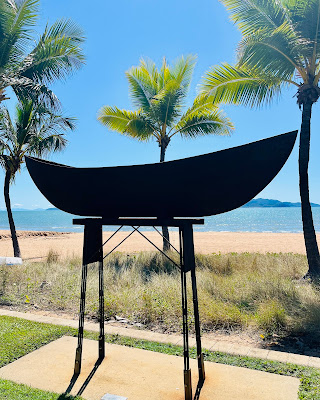 |
| Landboat (2005) by Bruce Anderson |
 |
| Three Bracelets (1999) by Thierry Auriac |
The artist has encircled the trunks of five coconut palms with coloured aluminium rings. The effect throws into sharp relief machine-made and naturally growing forms whilst considering the imposition of fabricated structure upon nature.
And at the end of the parade, this is the view back out to Magnetic Island.
Not a scultpure but an example of architecture that appeals.














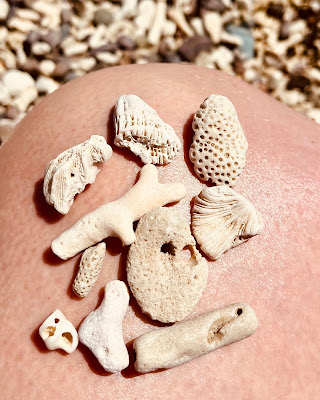



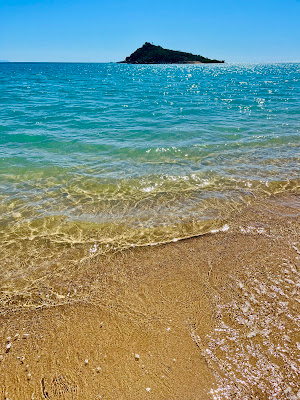






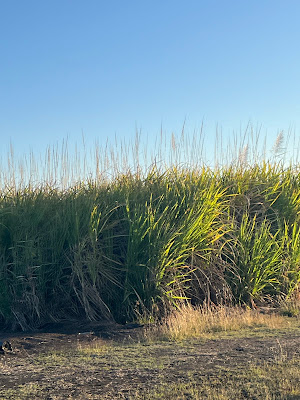
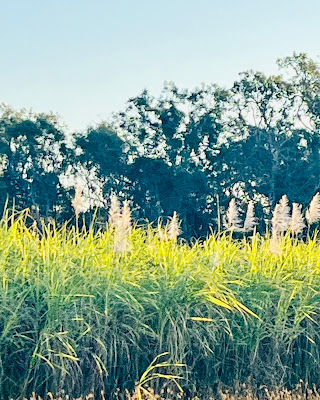


























No comments:
Post a Comment